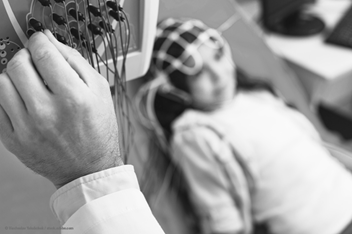Responsive Neurostimulation (RNS) for Epilepsy
What Is Responsive Neurostimulation (RNS)?
Responsive Neurostimulation (RNS) is a treatment designed to reduce seizures in children with epilepsy. This involves surgery where a small device, called a neurostimulator, is placed in your child’s skull. The device continuously monitors brain activity and detects patterns that could lead to a seizure. When it identifies this activity, the neurostimulator sends electrical pulses to the brain to interrupt the seizure before it starts. This personalized approach helps manage seizures and improve your child’s quality of life.Who Is a Candidate for RNS?
Every child’s epilepsy journey is unique. The epilepsy team will review your child’s medical history, brain scans, and test results to decide if RNS is a good option. RNS may be an option if:- Seizures aren’t controlled by medication: Your child’s seizures continue even after trying different anti-seizure medicines.
- Medication side effects: Your child experiences serious side effects from anti-seizure medicines.
- Other treatments haven’t worked: Your child is not a candidate for other epilepsy surgeries, or these surgeries haven’t worked in the past.
What Are the Benefits of RNS?
RNS is typically recommended for children with epilepsy whose seizures cannot be fully controlled with medications. It is considered a palliative surgery, meaning it is not designed to cure epilepsy but to reduce the number and severity of seizures.By monitoring brain activity and responding to patterns that could lead to a seizure, RNS helps stop seizures before they fully develop. This can improve your child’s safety and reduce the impact of seizures on their daily life. Over time, many children experience fewer seizures and shorter recovery times after seizures, which can allow them to participate more fully in school, activities, and family life.
RNS is personalized to your child’s unique seizure patterns, making it an effective and adaptable option. In addition to improving seizure control, it may also allow for reduced doses of anti-seizure medications, which can minimize side effects.
What Are the Risks of RNS?
While RNS surgery is generally safe, there are some risks involved, including:- Infection: There is a small risk of infection where the neurostimulator or electrodes are implanted.
- Bleeding or swelling in the brain: The placement of electrodes can sometimes cause minor bleeding or swelling in the brain. Serious complications are rare, but they are a possibility in any brain surgery.
- Device issues: The device or its components may malfunction, requiring adjustments or, in rare cases, additional surgery to repair or replace parts.
- Continued seizures: Some children may still experience seizures after surgery. In some cases, seizure types or patterns may change, requiring adjustments to the RNS device settings.
- Pain or discomfort: Your child may feel temporary pain or discomfort at the incision sites or around the device after surgery. This is usually manageable with medication.

Responsive neurostimulation (RNS) uses a small device placed in the skull with wires that go to the brain. It watches for seizure activity and sends small pulses to help stop seizures before they start.
Key: Size comparison (blue dot); Neurostimulator (orange dot)
What Happens During RNS Surgery?
During RNS surgery, your child will receive anesthesia, so they are asleep and won’t feel any pain. The neurosurgeon will make a small incision on your child’s scalp and create an opening in the skull to place the neurostimulator device. This device, smaller than a playing card, is secured inside the skull.
Thin wires, called electrodes, are then placed into the parts of the brain where seizures are believed to start. These wires are connected to the neurostimulator, which monitors brain activity and sends tiny electrical pulses to help stop seizures before they happen.
Once everything is in place, the surgeon will check to ensure the device is working correctly. The incision is then closed with stitches or staples, and a bandage is applied to protect the surgical site.
What Happens After RNS Surgery?
After the surgery, your child will be transferred to a recovery area where they will wake up from anesthesia. Doctors and nurses will closely monitor their healing. The surgical site will be checked regularly, and your child’s care team will watch for any signs of complications, such as swelling or infection. Pain is typically mild and managed with medication as needed.When your child has recovered most of the way, they will go home. Your child will continue their anti-seizure medicines at the usual doses and see the Neurology doctor a few weeks after surgery to have the RNS device adjusted. Regular follow-up appointments in our clinic are needed to monitor progress and make any needed adjustments.
Medical Reviewer: Ammar Shaikhouni, MD, PhD, Nationwide Children's Hospital
Date Last Reviewed: 7/25/2025
The information provided here is only for general reference and should not take the place of medical care or patient education. If you have any questions, please call our Epilepsy Surgery Clinic at (614) 722-4625.


